Method For The Synthesising 4-piperidin-4-yl-benzene-1,3-diol And The Salts Of Same And Novel Compound Tert-butyl 4-(2,4-dihydroxy-phenyl)-4-hydroxy-piperidine-1-carboxylate
BOITEAU; Jean-Guy ; et al.
U.S. patent application number 14/767544 was filed with the patent office on 2015-12-31 for method for the synthesising 4-piperidin-4-yl-benzene-1,3-diol and the salts of same and novel compound tert-butyl 4-(2,4-dihydroxy-phenyl)-4-hydroxy-piperidine-1-carboxylate. This patent application is currently assigned to Galderma Research & Development. The applicant listed for this patent is GALDERMA RESEARCH & DEVELOPMENT. Invention is credited to Jean-Guy BOITEAU, Branislav MUSICKI.
| Application Number | 20150376126 14/767544 |
| Document ID | / |
| Family ID | 51354631 |
| Filed Date | 2015-12-31 |

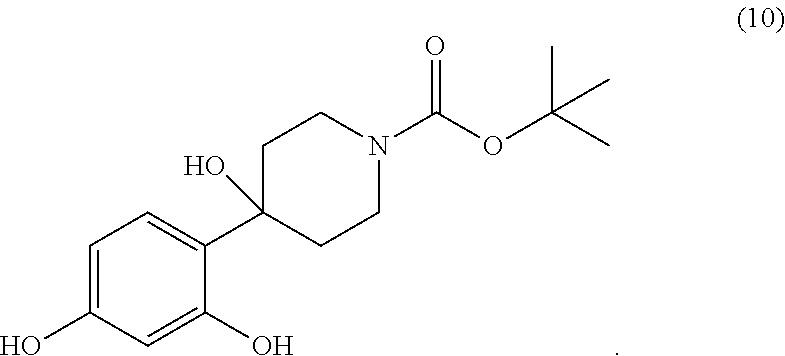










View All Diagrams
| United States Patent Application | 20150376126 |
| Kind Code | A1 |
| BOITEAU; Jean-Guy ; et al. | December 31, 2015 |
METHOD FOR THE SYNTHESISING 4-PIPERIDIN-4-YL-BENZENE-1,3-DIOL AND THE SALTS OF SAME AND NOVEL COMPOUND TERT-BUTYL 4-(2,4-DIHYDROXY-PHENYL)-4-HYDROXY-PIPERIDINE-1-CARBOXYLATE
Abstract
A method is described for the synthesis of 4-piperidin-4-yl-benzene-1,3-diol of the following formula (I): ##STR00001## and the pharmaceutically acceptable salts thereof. Also described, is tert-butyl 4-(2,4-dihydroxy-phenyl)-4-hydroxy-piperidine-1-carboxylate as a novel intermediate compound ##STR00002##
| Inventors: | BOITEAU; Jean-Guy; (Valbonne, FR) ; MUSICKI; Branislav; (Nice, FR) | ||||||||||
| Applicant: |
|
||||||||||
|---|---|---|---|---|---|---|---|---|---|---|---|
| Assignee: | Galderma Research &
Development Biot FR |
||||||||||
| Family ID: | 51354631 | ||||||||||
| Appl. No.: | 14/767544 | ||||||||||
| Filed: | February 14, 2014 | ||||||||||
| PCT Filed: | February 14, 2014 | ||||||||||
| PCT NO: | PCT/FR2014/050314 | ||||||||||
| 371 Date: | August 12, 2015 |
Related U.S. Patent Documents
| Application Number | Filing Date | Patent Number | ||
|---|---|---|---|---|
| 61764636 | Feb 14, 2013 | |||
| Current U.S. Class: | 546/217 ; 546/240 |
| Current CPC Class: | C07D 211/22 20130101; C07B 35/02 20130101; C07D 211/52 20130101 |
| International Class: | C07D 211/52 20060101 C07D211/52; C07D 211/22 20060101 C07D211/22 |
Foreign Application Data
| Date | Code | Application Number |
|---|---|---|
| Feb 14, 2013 | FR | 1351253 |
Claims
1. A method of synthesizing 4-piperidin-4-yl-benzene-1,3-diol corresponding to general formula (I) and salts thereof ##STR00022## the method comprising reacting a compound corresponding to general formula (10) ##STR00023## with hydrogen in the presence of a palladium-based catalyst in polar solvent and then reacting the obtained product with an inorganic or organic acid.
2. The method according to claim 1, wherein the compound corresponding to the general formula (10) is obtained by reacting the resorcinol with the azacycloalkanone of formula (9) ##STR00024## in the presence of a base and in polar solvent.
3. The method according to claim 1, wherein the polar solvent is selected from the group consisting of alcohols, carboxylic acids, esters, ethers, water, and a mixture thereof.
4. The method according to claim 3, wherein the alcohols are selected from the group consisting of methanol, ethanol and isopropanol.
5. The method according to claim 2, wherein the polar solvent is selected from the group consisting of water and alcohols.
6. The method according to claim 2, wherein the base is selected from the group consisting of sodium hydroxide, potassium hydroxide, lithium hydroxide, and metal alcoholates.
7. The method according to claim 1, wherein the palladium-based catalyst is selected from the group consisting of palladium on carbon, palladium hydroxide and palladium acetate.
8. The method according to claim 1, wherein the hydrogen pressure applied is from 1 bar to 10 bar.
9. The method according to claim 2, wherein the resorcinol and the azacycloalkanone (9) are used in a resorcinol/azacycloalkanone molar ratio from 1 to 8.
10. Tert-butyl 4-(2,4-dihydroxy-phenyl)-4-hydroxy-piperidine-1-carboxylate of the formula (10) ##STR00025##
11. The method according to claim 3, wherein when the solvent is an alcohol, the alcohol is methanol.
12. The method according to claim 3, wherein when the solvent is a carboxylic acid, the carboxylic acid is acetic acid.
13. The method according to claim 3, wherein when the solvent is an ester, the ester is ethyl acetate.
14. The method according to claim 3, wherein when the solvent is an ether, the ether is tetrahydrofuran.
15. The method according to claim 5, wherein when the polar solvent is an alcohol, it is selected from the group consisting of methanol, ethanol, isopropanol, n-butanol, and tert-butanol.
16. The method according to claim 6, wherein when the base is selected from the group consisting of sodium methanolate, sodium tert-butylate, potassium tert-butylate and lithium tert-butylate.
Description
[0001] The present invention relates to a process for the synthesis of 4-piperidin-4-yl-benzene-1,3-diol of the following formula (I):
##STR00003##
and pharmaceutically acceptable salts thereof.
[0002] The present invention also relates to the compound tert-butyl 4-(2,4-dihydroxy-phenyl)-4-hydroxy-piperidine-1-carboxylate of the formula (10)
##STR00004##
[0003] The synthesis of compounds similar to those of the compound (I) above and corresponding to the following general formula:
##STR00005##
wherein R is a hydrogen atom or a --COR.sup.1 radical was described in the patent application WO 2010/063774. Said synthesis is carried out in six steps (FIG. 1).
[0004] In the first step of said process (FIG. 1), the 2,4-dibenzyloxy bromobenzene (1) [X.dbd.Br; Y.dbd.H],
##STR00006##
reacts in the presence of butyllithium with the azacycloalkanones of the general formula (2) to yield the corresponding benzylic alcohols of the general formula (3)
##STR00007##
[0005] The alcohol functional group of the compound (3) is then removed by means of a reduction step, but these reducing conditions also cause deprotection of the phenol functional groups (removal of the benzyl protecting group) and give compound (4).
##STR00008##
[0006] Said reduction step is a disadvantage in said synthesis, because the phenol functional groups of the compound (4) must be reprotected in the following step to yield the compound (5)
##STR00009##
before being able to specifically eliminate the carbamate protecting group on the nitrogen of the compound (5) and to obtain the compound (6).
##STR00010##
[0007] From said compound (6), an acyl (--COR.sup.1) group is added on the nitrogen to yield the compound (7).
##STR00011##
[0008] Lastly, a final deprotection step (debenzylation) of the phenol functional groups yields the compounds of the formula (II).
##STR00012##
[0009] In total, said synthesis requires two steps of deprotection of the phenol functional groups (steps 2 and 6), one step of deprotection of the nitrogen functional group (step 4) and one step of protection of the phenol functional groups (step 3) to yield the compounds of the formula (I). Said succession of protection and deprotection steps thus constitutes a major disadvantage of the synthesis as described in the application WO 2010/063774, said disadvantage not allowing said synthesis to be adapted to an industrial scale.
[0010] The patent application WO 2011/070080 also describes a synthesis of compounds similar to the compound (I) above, compounds which correspond to the following general formula:
##STR00013##
wherein R is a hydrogen atom or an --SO.sub.2R.sup.1 radical. Said synthesis is carried out in four steps (FIG. 2).
[0011] In the first step of the process as described in the patent application WO 2011/070080 (FIG. 2), the 2,4-dibenzyloxy bromobenzene (1) [X.dbd.Br; Y.dbd.H],
##STR00014##
reacts in the presence of butyllithium with the azacycloalkanones of the general formula (2) to yield the corresponding benzylic alcohols of the general formula (3)
##STR00015##
[0012] During the following step, the reducing conditions applied reduce the alcohol functional group and deprotect the phenol functional groups to yield the compound (4).
##STR00016##
[0013] Said synthesis requires two more steps following compound (4) to yield the compounds of the formula (III)
##STR00017##
[0014] In the context of the development of the compounds of the formula (II) or (III), there is a need to have a simple and economical method for preparing in just a few steps and under safe conditions the 4-piperidin-4-yl-benzene-1,3-diol of the formula (I) while avoiding the disadvantages mentioned above.
[0015] The present invention thus aims to solve the problems cited above by proposing a process for the synthesis in two steps of the 4-piperidin-4-yl-benzene-1,3-diol of the formula (I) or salts thereof, easily adapted to an industrial scale.
[0016] The subject matter of the present invention relates to a process for the synthesis of the 4-piperidin-4-yl-benzene-1,3-diol corresponding to the general formula (I) and salts thereof
##STR00018##
characterized in that the compound corresponding to the general formula (10)
##STR00019##
reacts first with hydrogen in the presence of a palladium-based catalyst in polar solvent and then with an inorganic or organic acid.
[0017] Preferably, the polar solvent is selected from the group comprising alcohols such as methanol, ethanol and isopropanol, for example, carboxylic acids such as acetic acid, for example, esters such as ethyl acetate, for example, ethers such as tetrahydrofuran, for example, water, and a mixture of said solvents. Advantageously, the polar solvent is an alcohol selected from methanol, ethanol and isopropanol.
[0018] Preferably, the palladium-based catalyst is selected from the group consisting of palladium on carbon, palladium hydroxide and palladium acetate.
[0019] Preferably, the hydrogen pressure applied in the process of the invention is between 1 bar and 10 bar.
[0020] In a particular embodiment, the compound corresponding to the general formula (10) is obtained by reacting the resorcinol with the azacycloalkone of the formula (9)
##STR00020##
in the presence of a base and in polar solvent.
[0021] Preferably, the polar solvent is selected from the group comprising water and alcohols, preferably methanol, ethanol, isopropanol, n-butanol and tert-butanol.
[0022] Preferably, the base is selected from the group comprising sodium hydroxide, potassium hydroxide, lithium hydroxide, metal alcoholates, preferably sodium methanolate, sodium tert-butylate, potassium tert-butylate or lithium tert-butylate.
[0023] Preferably, the resorcinol and the azacycloalkanone (9) are used in a resorcinol/azacycloalkanone molar ratio between 1 and 8.
[0024] Another subject matter of the invention relates to the tert-butyl 4-(2,4-dihydroxy-phenyl)-4-hydroxy-piperidine-1-carboxylate of the formula (10)
##STR00021##
[0025] As illustrated in FIG. 3, the novel process for synthesis of the 4-piperidin-4-yl-benzene-1,3-diol (I), the subject matter of the present invention, is a short synthesis comprising two steps.
[0026] Said novel synthetic pathway uses the resorcinol (8) as the starting product, which is very advantageous economically compared with the price of the 2,4-dihydroxy bromobenzene (1) used in the syntheses described in applications WO 2010/063774 and WO 2011/070080.
[0027] The first step of said novel synthetic pathway is an original step of coupling the resorcinol (8) with the azacycloalkanone (9) in the presence of a base. The base used is selected preferably from the group comprising sodium hydroxide, potassium hydroxide, lithium hydroxide, and metal alcoholates such as sodium methanolate, sodium tert-butylate, potassium tert-butylate or lithium tert-butylate, for example. Said step is carried out in polar solvent, preferably in water or alcohols, or in a mixture of said solvents, and produces the compound (10) directly. The alcohols are selected preferably from the group comprising methanol, ethanol, isopropanol, n-butanol and tert-butanol.
[0028] During said first step, excess resorcinol (8) is preferably used to react on the azacycloalkanone (9). More specifically, the resorcinol (8)/azacycloalkanone (9) molar ratio is between 1 and 8, preferably between 2 and 4.
[0029] The temperature at which said coupling step is carried out is another advantage of said novel synthetic pathway. Indeed, said first step is carried out at room temperature, in water or alcohols, which avoids the cryogenic step (-78.degree. C.) of the processes disclosed in WO 2010/063774 and WO 2011/070080. Furthermore, the reaction intermediate (10) of said first step is obtained in crystalline form, thus avoiding the need for purification steps. Thus, techniques for separation on a chromatography column to isolate the intermediate (10) are not necessary, which is another advantage for the adaptation of said process to an industrial scale.
[0030] The second step of said novel synthetic pathway is a hydrogenation reaction of the intermediate (10) to obtain the 4-piperidin-4-yl-benzene-1,3-diol (I).
[0031] The hydrogenation of the intermediate (10) is carried out in polar solvent. The preferred polar solvents are selected from the group comprising alcohols such as methanol, for example, carboxylic acids such as acetic acid, for example, esters such as ethyl acetate, for example, ethers such as tetrahydrofuran, for example, water, and a mixture of said solvents. The alcohols are selected preferably from the group comprising methanol, ethanol and isopropanol. Hydrogenation is carried out in the presence of a palladium-based catalyst. The preferred catalysts are selected from the group consisting of palladium on carbon, palladium hydroxide, palladium acetate, or any other reduction catalyst known to the skilled person. The hydrogen pressure applied is between 1 bar and 10 bar, preferably between 3 bar and 7 bar.
[0032] Said step has the advantage of producing the 4-piperidin-4-yl-benzene-1,3-diol (I) as a salt after the addition of an inorganic or organic acid to the reaction medium. The tert-butyl carbamate group protecting the nitrogen of the compound (10) is then cleaved in situ by the inorganic or organic acid to yield the 4-piperidin-4-yl-benzene-1,3-diol (I) as a salt.
[0033] The inorganic acids used to obtain a salt of the 4-piperidin-4-yl-benzene-1,3-diol (I) are selected from the group comprising hydrochloric acid and sulphuric acid, for example.
[0034] The organic acids used to obtain a salt of the 4-piperidin-4-yl-benzene-1,3-diol (I) are selected from the group comprising trifluoromethanesulphonic acid and trifluoroacetic acid.
[0035] Said process thus has the advantage of providing the 4-piperidin-4-yl-benzene-1,3-diol (I) or a salt thereof in at most two reaction steps and is, therefore, much easier to adapt to an industrial scale than the processes of the prior art.
DESCRIPTION OF THE FIGURES
[0036] FIG. 1: Preparation of compounds of the formula (II) described in WO 2010/063774
[0037] FIG. 2: Preparation of compounds of the formula (III) described in WO 2011/070080
[0038] FIG. 3: Process for preparing the compounds of the invention of the formula (I) and salts thereof.
EXAMPLES
[0039] The following examples are now presented in order to illustrate the process as described above. Said examples which illustrate the process of the invention are not limiting.
Example 1
4-Piperidin-4-yl-benzene-1,3-diol hydrochloride
Step 1
4-(2,4-Dihydroxy-phenyl)-4-hydroxy-piperidine-1-carboxylic acid tert-butyl ester
[0040] In a 4 liter reactor equipped with a mechanical stirrer and a thermometer, resorcinol (371.25 g) is placed in tert-butanol (2 L) at room temperature. To this heterogeneous mixture is then added potassium tert-butylate (378.0 g) over 5 min. The temperature increases to 55.degree. C. and the reaction mixture becomes black. The reaction is stirred for 30 min allowing the mixture to cool to 38.degree. C. Next, tert-butyl carboxylate (167.9 g) is added to the reaction mixture over 2 to 3 minutes. The addition is endothermic, lowering the temperature to 35.degree. C. The reaction is then stirred for 1 hour until room temperature is reached. The reaction mixture is then added to a solution of NaH.sub.2PO.sub.4 (700 g) in water (5 l) and the aqueous phase is then extracted with 4 liters of an ethyl acetate/heptane (1:1) mixture. The organic phase is separated and washed with water (10.times.5 l). This operation is carried out until the resorcinol of the aqueous phase completely disappears (checked by TLC). The organic phase is then dried over Na.sub.2SO.sub.4 and the solvents are evaporated to yield 263 g of residue. The residue is dissolved in a minimum of dichloromethane and filtered on a silica gel patch using an ethyl acetate/heptane (1:1) mixture. After evaporation of the solvent (concentration), a solid begins to crystallise slowly. After 30 minutes, 117 g of tert-butyl 4-(2,4-dihydroxy-phenyl)-4-hydroxy-piperidine-1-carboxylate is obtained.
[0041] (Yield=45%).
[0042] .sup.1H NMR (DMSO D6, 400 MHz): 1.40 (s, 9H); 1.52 (d, J=12.8 Hz, 2H); 2.10 (m, 1H); 3.08 (br s, 2H); 3.79 (br s, 2H); 5.35 (br s, 1H); 6.17 (dd, J=2.4 Hz, 8.3 Hz, 1H); 6.21 (d, J=2.4 Hz, 1H); 7.08 (d, J=8.2 Hz, 1H); 9.09 (br s, 1H); 9.47 (br s, 1H).
Step 2
4-Piperidin-4-yl-benzene-1,3-diol hydrochloride
[0043] In a 1 liter hydrogenation reactor, 70 g of tert-butyl 4-(2,4-dihydroxy-phenyl)-4-hydroxy-piperidine-1-carboxylate (0.226 mol) is dissolved in 500 ml of glacial acetic acid with 4 g of 10% palladium on carbon (Pd/C) and the mixture is hydrogenated at 5 bar and 35.degree. C. for 3 hours. During hydrogenation, the temperature increases to 65.degree. C. After 3 hours, 500 ml of ethyl acetate is added to the reaction mixture and the solution is filtered on Celite. On said filtrate, 150 ml of a 4 M solution of HCl dissolved in ethyl acetate is then added dropwise and after 2 hours of stirring the precipitate formed is filtered, yielding 36 g of 4-piperidin-4-yl-benzene-1,3-diol hydrochloride as white crystals.
[0044] Yield=69%
[0045] .sup.1H NMR (DMSO D6, 400 MHz): 1.80 (m, 4H); 2.92 (m, 3H); 3.28 (d, J=12 Hz, 2H); 6.18 (dd, J=2.4 Hz, 8.3 Hz, 1H); 6.34 (d, J=2.4 Hz, 1H); 6.77 (d, J=8.2 Hz, 1H); 8.93 (br s, 1H); 9.10 (br s, 1H); 9.36 (s, 1H).
[0046] .sup.13C NMR (DMSO D6, 100 MHz): 28.3; 32.4; 43.8; 102.5; 106.1; 121.1; 126.5; 155.3; 156.5.
* * * * *















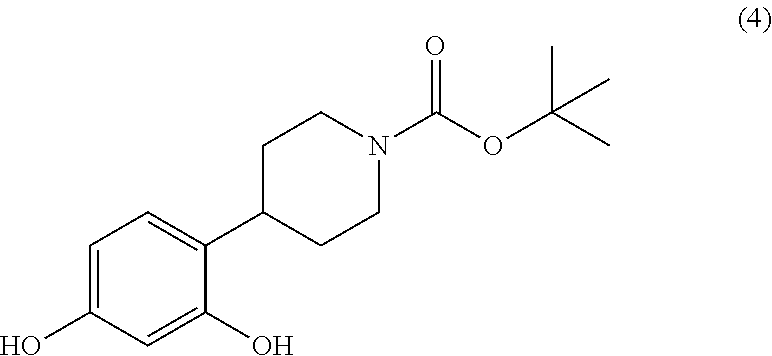
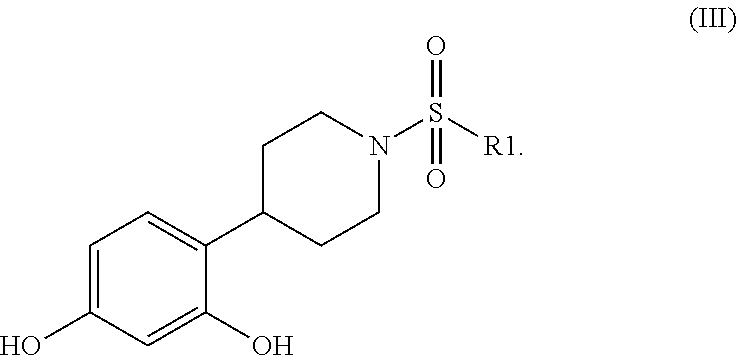


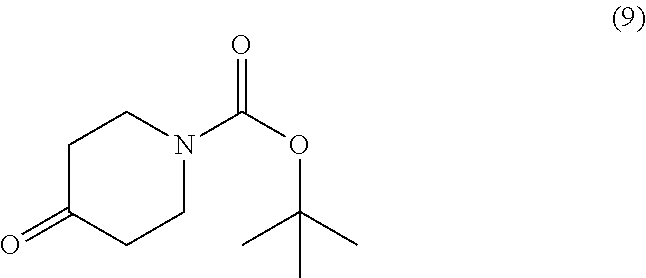
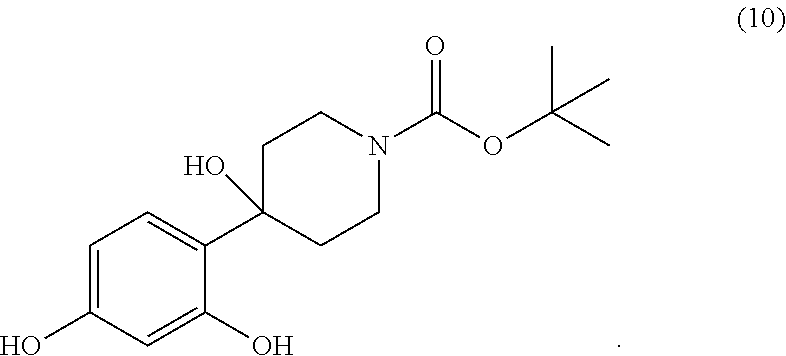

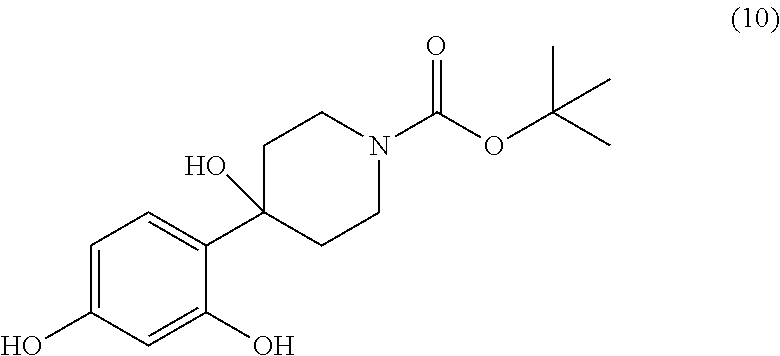


D00000

D00001

D00002

XML
uspto.report is an independent third-party trademark research tool that is not affiliated, endorsed, or sponsored by the United States Patent and Trademark Office (USPTO) or any other governmental organization. The information provided by uspto.report is based on publicly available data at the time of writing and is intended for informational purposes only.
While we strive to provide accurate and up-to-date information, we do not guarantee the accuracy, completeness, reliability, or suitability of the information displayed on this site. The use of this site is at your own risk. Any reliance you place on such information is therefore strictly at your own risk.
All official trademark data, including owner information, should be verified by visiting the official USPTO website at www.uspto.gov. This site is not intended to replace professional legal advice and should not be used as a substitute for consulting with a legal professional who is knowledgeable about trademark law.